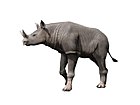
Eutamias is a genus of chipmunks within the tribe Marmotini of the squirrel family. It includes a single living species, the Siberian chipmunk. The genus is often treated as a subgenus of Tamias, which is now restricted to the eastern chipmunk of North America. Neotamias, which now includes the western North American chipmunks, has also been included in Eutamias.

Paraceratherium is an extinct genus of hornless rhinocerotoids belonging to the family Paraceratheriidae. It is one of the largest terrestrial mammals that has ever existed and lived from the early to late Oligocene epoch. The first fossils were discovered in what is now Pakistan, and remains have been found across Eurasia between China and the Balkans. Paraceratherium means "near the hornless beast", in reference to Aceratherium, the genus in which the type species P. bugtiense was originally placed.

Paraceratheriidae is an extinct family of long-limbed, hornless rhinocerotoids, native to Asia and Eastern Europe that originated in the Eocene epoch and lived until the end of the Oligocene. They represent some of the largest terrestrial mammals to have ever lived.

Hyaenodon ("hyena-tooth") is an extinct genus of carnivorous placental mammals from extinct tribe Hyaenodontini within extinct subfamily Hyaenodontinae, that lived in Eurasia and North America from the middle Eocene, throughout the Oligocene, to the early Miocene.

Yixianosaurus is a maniraptoran theropod dinosaur genus from the Early Cretaceous of China.
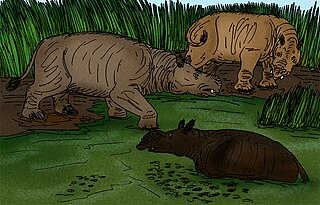
Amynodontidae is a family of extinct perissodactyls related to true rhinoceroses. They are commonly portrayed as semiaquatic hippo-like rhinos but this description only fits members of the Metamynodontini; other groups of amynodonts like the cadurcodontines had more typical ungulate proportions and convergently evolved a tapir-like proboscis.
The Subashi Formation is a Late Cretaceous formation from the Xinjiang Autonomous Region of western China. Initially described by Dong Zhiming in 1977, the formation contains remains of Tarbosaurus which were initially described as a separate taxon Shanshanosaurus huoyanshanensis. Remains of a sauropod, likely Nemegtosaurus, and a hadrosaurid, likely Jaxartosaurus, have also been found.
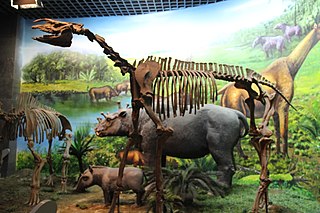
Juxia, ‘joo-she-a’, is an extinct genus of paraceratheriid, a group of herbivorous mammals that are related to the modern rhinoceros. The type species is Juxia sharamurenensis, named by Zhou Mingzhen and Qiu Zhanxiang in 1964. Juxia was around the size of a horse. It lived in Asia during the upper Eocene.

Tillodontia is an extinct suborder of eutherian mammals known from the Early Paleocene to Late Eocene of China, the Late Paleocene to Middle Eocene of North America where they display their maximum species diversity, the Middle Eocene of Pakistan, and the Early Eocene of Europe. Leaving no descendants, they are most closely related to the pantodonts, another extinct group. The tillodonts were medium- to large-sized animals that probably fed on roots and tubers in temperate to subtropical habitats.

Ovaloolithus is an oogenus of dinosaur egg. Eggs of the genus have been found in China, Mongolia and Utah.
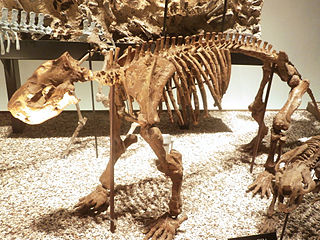
Bemalambdidae is an extinct family of pantodont mammals known from Early and Middle Paleocene of China.

Coryphodontidae is an extinct family of pantodont mammals known from the Late Paleocene to the Middle Eocene of Eurasia and North America.
Eggysodontidae is a family of perissodactyls, closely related to rhinoceroses. Fossils have been found in Oligocene deposits in Europe, the Caucasus, Central Asia, China, and Mongolia.
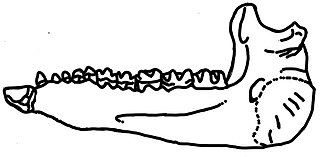
Urtinotherium is an extinct genus of paracerathere mammals. It was a large animal that was closely related to Paraceratherium, and found in rocks dating from the Late Eocene to Early Oligocene period. The remains were first discovered in the Urtyn Obo region in Inner Mongolia, which the name Urtinotherium is based upon. Other referred specimens are from northern China.
The Ermaying Formation is a geological formation of Anisian age in north-central China. It is found across much of the Ordos Basin, at outcrops within the provinces of Shaanxi, Shanxi, and Inner Mongolia. It is composed of up to 600 m thick sequence of mudstone and sandstone, overlying the Heshanggou Formation and underlying the Tongchuan Formation. In the southern part of the Ordos Basin, the Zhifang Formation is equivalent to the Ermaying Formation.
Allacerops is an extinct genus of odd-toed ungulate belong to the rhinoceros-like family Eggysodontidae. It was a small, ground-dwelling browser, and fossils have been found in Oligocene deposits throughout Central and East Asia.

Dzungariotherium is a genus of paraceratheriid, an extinct group of large, hornless rhinocerotoids, which lived during the middle and late Oligocene of northwest China. The type species D. orgosense was described in 1973 based on fossils—mainly teeth—from Dzungaria in Xinjiang, northwest China.
Aralotherium is an extinct genus of hornless rhinocerotoids closely related to Paraceratherium, one of the largest terrestrial mammals that has ever existed. It lived in China and Kazakhstan during the late Oligocene epoch. It is classified as a member of the Paraceratheriidae subfamily Paraceratheriinae.

Bemalambda is a genus of extinct mammal, belonging to the pantodonts. It lived in the lower-middle Paleocene and the fossil remains have been found in China.

Ballusia is a genus of small bear from the Early Miocene epoch, about 20.5-18 million years ago. Fossil remains attributed to the genus have been uncovered in Europe (Poland) and Asia. The genus Ballusia was established in 1998 on the basis of different fossils originally classified as various species of the genera Ursavus and Hemicyon, with B. elmensis as the type species. The exact relationship of Ballusia to "true" bears are not yet fully understood: many palaeontologists have classified it as a primitive member of Ursinae, but its known skeletal elements have some features in common with the extinct bear subfamily Hemicyoninae. Because of this, some researchers refer Ballusia as "Ursidae incertae sedis". Ginsburg and Morales regarded B. elmenensis as ancestral to Ursavus, as did Marciszak and Lipecki, even though the temporal range of the two genera seems to have overlapped.






















